Affiliate links on Android Authority may earn us a commission. Learn more.
Snapdragon 8 Gen 2 deep dive: Everything you need to know
Published onFebruary 8, 2024
In late 2022, Qualcomm lifted the lid on its latest mobile platform — the Snapdragon 8 Gen 2. Building on the Snapdragon 8 Gen 1 in more than just name, Qualcomm’s latest entry in its flagship Snapdragon series packs a number of improvements and new features for high-end smartphones in 2023 and beyond.
There’s a lot to dive into in much greater detail. Between an all-new CPU cluster arrangement, a ray tracing-capable GPU, high-end audio features and connectivity, and a deeper infusion of imaging and machine learning, the Snapdragon 8 Gen 2 sports a lot of firsts for Qualcomm.
The Samsung Galaxy S23 series was among the very first phones to utilize Qualcomm’s flagship chipset, with a more powerful Snapdragon 8 Gen 2 for Galaxy implementation. The version included is slightly overclocked, running a Cortex-X3 CPUat 3.36GHz instead of its default of 3.19GHz. Brands including HONOR, OnePlus, Sony, and others have adopted the processor since. Here are some other phones running on the Snapdragon 8 Gen 2 that are available now or coming soon.
Snapdragon 8 Gen 2 versus Snapdragon 8 Gen 1
| Snapdragon 8 Gen 2 | Snapdragon 8 Gen 1 | Snapdragon 888 | |
|---|---|---|---|
CPU Config | Snapdragon 8 Gen 2 1x 3.19GHz (Cortex-X3) 2x 2.8GHz (Cortex-A715) 2x 2.8GHz (Cortex-A710) 3x 2.0GHz (Cortex-A510) | Snapdragon 8 Gen 1 1x 3.0GHz (Cortex-X2) 3x 2.5GHz (Cortex-A710) 4x 1.8GHz (Cortex-A510) | Snapdragon 888 1x 2.84GHz (Cortex-X1) 3x 2.4GHz (Cortex-A78) 4x 1.8GHz (Cortex-A55) |
GPU | Snapdragon 8 Gen 2 Adreno 740 (ray tracing support) | Snapdragon 8 Gen 1 Adreno 730 | Snapdragon 888 Adreno 660 |
DSP | Snapdragon 8 Gen 2 Hexagon (fused scalar, tensor, and vector) Mixed precision INT8/INT16 INT4 support | Snapdragon 8 Gen 1 Hexagon (fused scalar, tensor, and vector) Mixed precision INT8/INT16 | Snapdragon 888 Hexagon 780 (fused scalar, tensor, and vector) |
RAM support | Snapdragon 8 Gen 2 LPDDR5X | Snapdragon 8 Gen 1 LPDDR5 | Snapdragon 888 LPDDR5 |
Camera support | Snapdragon 8 Gen 2 • 200MP single shot • 108MP single with zero shutter lag • 64MP+36MP with zero shutter lag • Triple 36MP with zero shutter lag • Hybrid AF • 10-bit HEIF image capture • HDR video • Multi-frame noise reduction • Real-time object classification, segmentation, and replacement • Video super resolution | Snapdragon 8 Gen 1 • 200MP single shot • 108MP single with zero shutter lag • 64MP+36MP with zero shutter lag • Triple 36MP with zero shutter lag • Hybrid AF • 10-bit HEIF image capture • HDR video • Multi-frame noise reduction • Real-time object classification, segmentation, and replacement • Video super resolution | Snapdragon 888 • 200MP single shot • 84MP single with zero shutter lag • 64MP+25MP with zero shutter lag • Triple 24MP with zero shutter lag • Hybrid AF • 10-bit HEIF image capture • HDR video • Multi-frame noise reduction • Real-time object classification, segmentation, and replacement |
Video capture | Snapdragon 8 Gen 2 8K @ 30fps (HDR) 4K UHD @ 120fps 720p @ 960fps | Snapdragon 8 Gen 1 8K @ 30fps (HDR) 4K UHD @ 120fps 720p @ 960fps | Snapdragon 888 8K @ 30fps 4K UHD @ 120fps 720p @ 960fps |
Video playback | Snapdragon 8 Gen 2 8K up to 60fps 4K HDR up to 120fps AV1, H.265 and VP9 video decoder 360 degree | Snapdragon 8 Gen 1 8K 4K HDR up to 120fps H.265 and VP9 video decoder 360 degree | Snapdragon 888 8K 4K HDR up to 120fps H.265 and VP9 video decoder 360 degree |
Charging | Snapdragon 8 Gen 2 Quick Charge 5 | Snapdragon 8 Gen 1 Quick Charge 5 | Snapdragon 888 Quick Charge 5 |
4G/5G Modem | Snapdragon 8 Gen 2 X70 LTE/5G (integrated) 10,000Mbps down 3,500Mbps up | Snapdragon 8 Gen 1 X65 LTE/5G (integrated) 10,000Mbps down (3,000Mbps up assumed) | Snapdragon 888 X60 LTE/5G (integrated) 7,500Mbps down 3,000Mbps up |
Other networking | Snapdragon 8 Gen 2 Bluetooth 5.3 Wi-Fi 7, Wi-Fi 6/6E (802.11ax), Wi-Fi 5 (802.11ac), 802.11a/b/g/n | Snapdragon 8 Gen 1 Bluetooth 5.2 Wi-Fi 6E, Wi-Fi 6 (802.11ax), Wi-Fi 5 (802.11ac), 802.11a/b/g/n | Snapdragon 888 Bluetooth 5.2 Wi-Fi 6E, Wi-Fi 6 (802.11ax), Wi-Fi 5 (802.11ac), 802.11a/b/g/n |
Process | Snapdragon 8 Gen 2 TSMC 4nm (N4?) | Snapdragon 8 Gen 1 Samsung 4nm 4LPE | Snapdragon 888 Samsung 5nm LPE |
Snapdragon 8 Gen 2 benchmarks
If you’re here for the performance metrics, let’s jump straight into some Snapdragon 8 Gen 2 benchmarks. First, we can compare the reference devices that Qualcomm makes available at its annual tech summit, giving us an idealized like-for-like comparison point between generations. However, Qualcomm’s reference units intend to showcase the chip’s real-world potential and may not reflect the results we see in retail products.
Key takeaways are that CPU single-core and multi-scores jumped 20% and 38% between Gen 1 and Gen 2 reference phones, respectively. This is reflected in retail phones too; there’s a 23% uplift in the Geekbench 5 multi-core compared to 2022’s ROG Phone 6, and it outmuscles the Galaxy S22 Ultra by a colossal 51%. That shows the extent of the Snapdragon 8 Gen 1’s overheating issues and reminds us to be cautious that the results scored by Qualcomm’s reference phone might not translate over to retail handsets. The gap isn’t as big with the 8 Plus Gen 1, but the newer 8 Gen 2 still sees solid returns, particularly in multi-core CPU scores.
System-testing Antutu sees a 24% uplift, while PCMark Work 3.0 sees a far more modest 10% gain between the first and second-generation chipsets. Qualcomm’s Adreno graphics are more impressive, with a 30% gain for 3DMark Wildlife and a 40% lead in GFXBench’s Aztec Ruins. However, the older GFXBench T-Rex barely moved the needle at all, with a 1.9% improvement. This suggests that older APIs and game engines won’t see the same performance improvements as those using the latest OpenGL and Vulkan graphics APIs. At least, that’s what the reference units suggest.
Leaderboard
With retail handsets on the market, we can compare and contrast Qualcomm’s idealized performance point against phones you can actually buy today. The results aren’t quite as clear-cut as Qualcomm’s idealized reference handset implementations, especially with the higher-clocked Snapdragon 8 Gen 2 for Galaxy version too. Here’s our benchmark leaderboard.
There are a few things to note about the fastest smartphones available in 2023. First, Apple’s CPU tops the 2022/23 leaderboard for sheer power, but the fastest Android phones aren’t too far behind. Secondly, most of the top-performing Android phones, from a CPU perspective, have their performance modes enabled. It’s increasingly common to see phones offer a lower performance point out of the box to save battery life and reduce thermals. This doesn’t affect responsiveness or seem to have a bearing on gaming performance, which is much more demanding, but we’re keeping an eye on this behavior and throttling.
Perhaps the biggest takeaway is that Snapdragon 8 Gen 2 smartphones surpass Apple’s iPhone 14 series in the graphics department. Impressively, the Samsung Galaxy S23 Ultra, with its higher-clocked GPU, comes out on top in the 3DMark test. However, running a stress test reveals that the phone isn’t the best at sustaining this performance over longer play sessions.
However, there’s clearly still a lot of diversity in the flagship smartphone space when it comes to graphics battery and heat optimizations. 3DMark’s stress test is more demanding than your typical gaming workload. However, if you demand peak sustained performance and want extra futureproofing, gaming phones still have a little extra to offer than other flagship smartphones.
Snapdragon 8 Gen 2 CPU arrangement explained
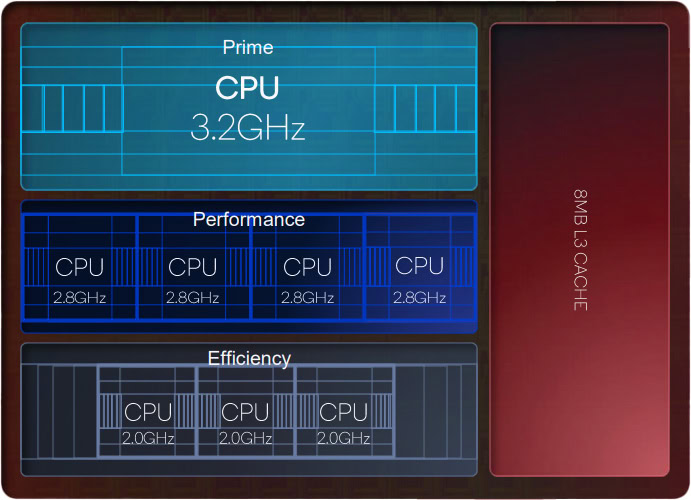
One of the instantly noticeable changes to the Snapdragon 8 Gen 2 is the move from the tried and tested 1+3+4 CPU cluster arrangement to a more novel 1+4+3 setup. In addition, Qualcomm has opted for two different CPU cores in the middle/performance cluster, based on two newer Arm Cortex-A715s and two last-gen Cortex-A710s. That’s bound to boost multi-core benchmarking scores, but it’s also clearly a very specific design choice.
According to Qualcomm, the reasoning came down to continuing support for legacy applications. The Cortex-A710 is the last of Arm’s cores to support 32-bit applications (AArch32) — all subsequent and future cores are 64-bit only (AAarch64), at least in theory. The Snapdragon 8 Gen 2 also uses Arm’s refreshed Cortex-A510 little cores, which, along with a 5% reduction in power consumption, can be built with 32-bit support as of 2022.
Ensuring legacy 32-bit support results in a unique CPU layout in the 8 Gen 2.
Qualcomm has indeed built the revised A510s with 32-bit support, providing a total of five cores capable of supporting legacy apps. Combined with the two A710 performance cores, this should provide an acceptable level of performance for 32-bit applications that goes beyond the four A510 core support seen in the MediaTek Dimensity 9200. However, they won’t run as well as 64-bit apps on this chip, which can leverage all the chip’s cores, so it will be interesting to see how more demanding legacy apps perform. Even so, 32-bit support could be redundant for many Snapdragon users and could even be a poor trade-off for battery life when you consider the loss of one little efficiency core. However, Qualcomm claims to have further optimized the performance cores to mitigate the issue.
See, Google has mandated 64-bit application support since 2019. Any app updated on the Play Store in recent years is now 64-bit. Even so, including the A710 and revised A510 cores ensures that the Snapdragon 8 Gen 2 will work with older applications and those that fall outside of Google’s Android ecosystem. Think China or third-party app stores that are further behind in mandating 64-bit support.
An extra middle core boosts multi-core workloads, but what about low power use cases?
A powerhouse Arm Cortex-X3 rounds out the CPU clusters, providing a decent chunk of the claimed 35% performance improvement, along with the extra middle core. When it comes to efficiency, Qualcomm claims up to a 40% improvement overall. The bulk of this comes from the move to TSMC’s 4nm process (Qualcomm wouldn’t confirm if it is using TSMC’s N4 or newer N4P process, so we’re presuming the former), but it’s still an impressive figure given the loss of one efficiency core. We saw similar benefits when Qualcomm moved from Samsung to TSMC for the Snapdragon 8 Plus Gen 1.
| Performance cluster | Middle Cluster | Efficiency Cluster | |
|---|---|---|---|
CPU cores | Performance cluster 1x Arm Cortex-X3 | Middle Cluster 2x Arm Cortex-A715 2x Arm Cortex-A710 | Efficiency Cluster 3x Arm Cortex-A510 |
Clock Speed | Performance cluster 3.19GHz | Middle Cluster 2.8GHz | Efficiency Cluster 2.0GHz |
L1 cache | Performance cluster (unknown) | Middle Cluster (unknown) | Efficiency Cluster (unknown) |
L2 cache | Performance cluster 1MB | Middle Cluster (unknown) | Efficiency Cluster (unknown) |
L3 cache | Performance cluster 8MB (shared) | Middle Cluster 8MB (shared) | Efficiency Cluster 8MB (shared) |
64/32-bit support | Performance cluster 64-bit only | Middle Cluster 2x A715: 64-bit only 2x A710: 64 and 32-bit | Efficiency Cluster 64 and 32-bit |
The table above provides an overview of the CPU setup, at least as far as Qualcomm would confirm to us. We don’t have full cache info, which could have performance implications for the middle and efficiency cores. Still, Qualcomm has provided a larger shared L3 cache, now 8MB up from 6MB, which will play a role in maximizing performance in heavily multi-threaded workloads with the additional middle core.
Ray tracing graphics for mobile
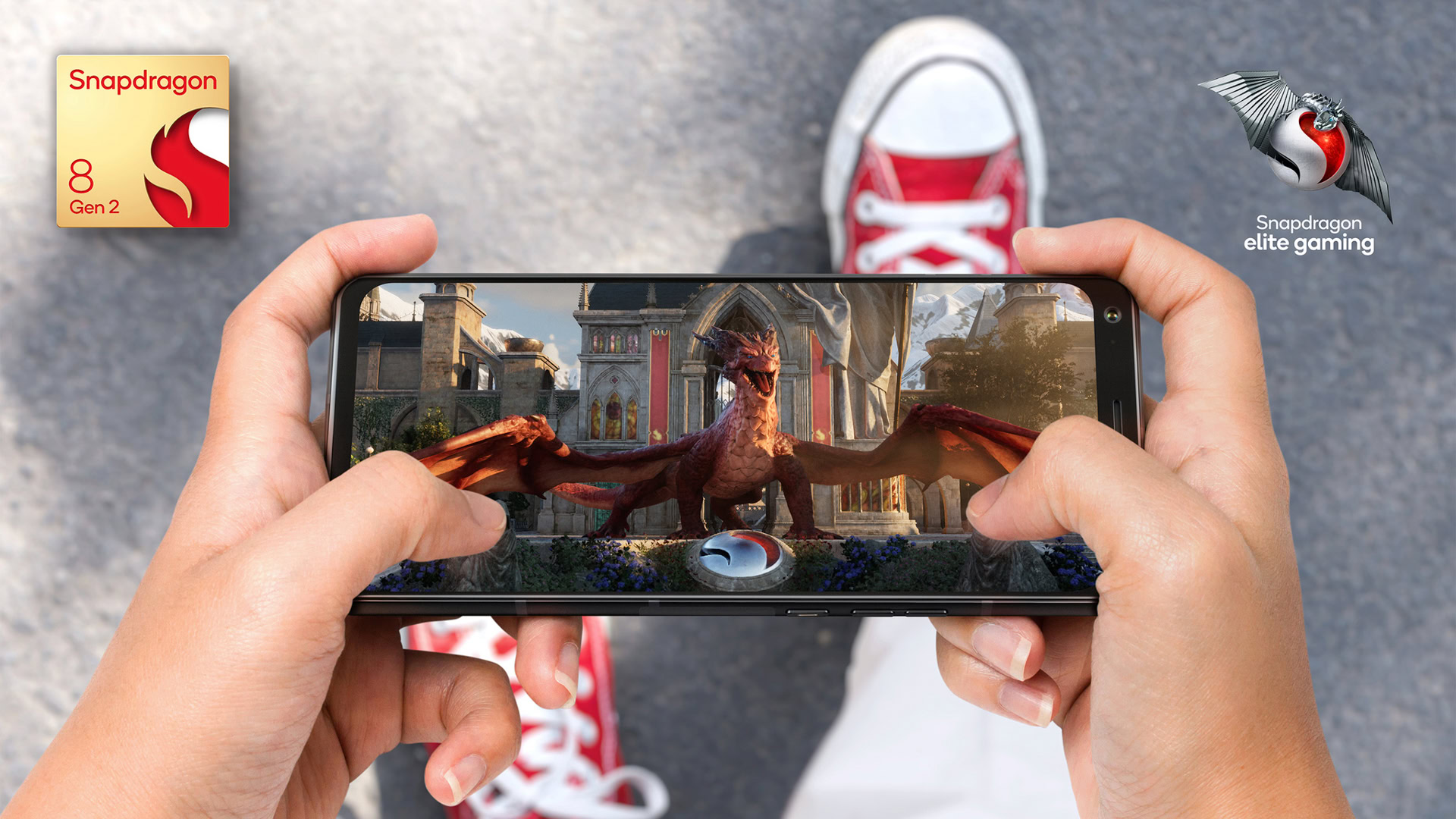
Now for, arguably, the head-line grabbing feature — mobile ray tracing graphics hardware goes mainstream. Qualcomm isn’t the first to announce hardware-accelerated ray tracing features for mobile; it joins the AMD Xclipse GPU in Samsung’s Exynos 2200 and the Arm Immortalis-G715 inside MediaTek’s Dimensity 9200. But Qualcomm’s shipment volume makes this the announcement that can make mobile ray-tracing viable for developers.
Frustratingly, Qualcomm keeps its Adreno GPU technology a closely guarded secret. But we know that the Snapdragon 8 Gen 2 accelerates ray-box and ray-triangle intersections. Importantly, there’s Bounding Volume Hierarchical (BVH) acceleration (or retrieval and decompression acceleration structure nodes, as Qualcomm calls it), too, significantly increasing the GPU’s ability to test ray collisions optimally.
Developers can leverage ray tracing to build soft shadows, reflections, and global illumination into the games.
Based on these details, Qualcomm’s implementation provides BVH support, whereas Arm’s option does not. However, Qualcomm hasn’t told us exactly how powerful the Snapdragon 8 Gen 2’s accelerator really is or how well its ray tracing hardware scales. Although we’re waiting for real-world games, initial mobile ray tracing benchmarks point to the AMD Xclipse and Arm Immortalis-G715 GPUs having a performance advantage over Qualcomm’s setup.
Even so, according to Qualcomm partner OPPO, the company’s open-sourced PhysRay engine can increase ray tracing rendering efficiency by a factor of 5x and reduce CPU workloads by 90% compared with running the same effects in software. The company claims a locked 60fps at 720p for 30 minutes, running its ray tracing engine on the 8 Gen 2.
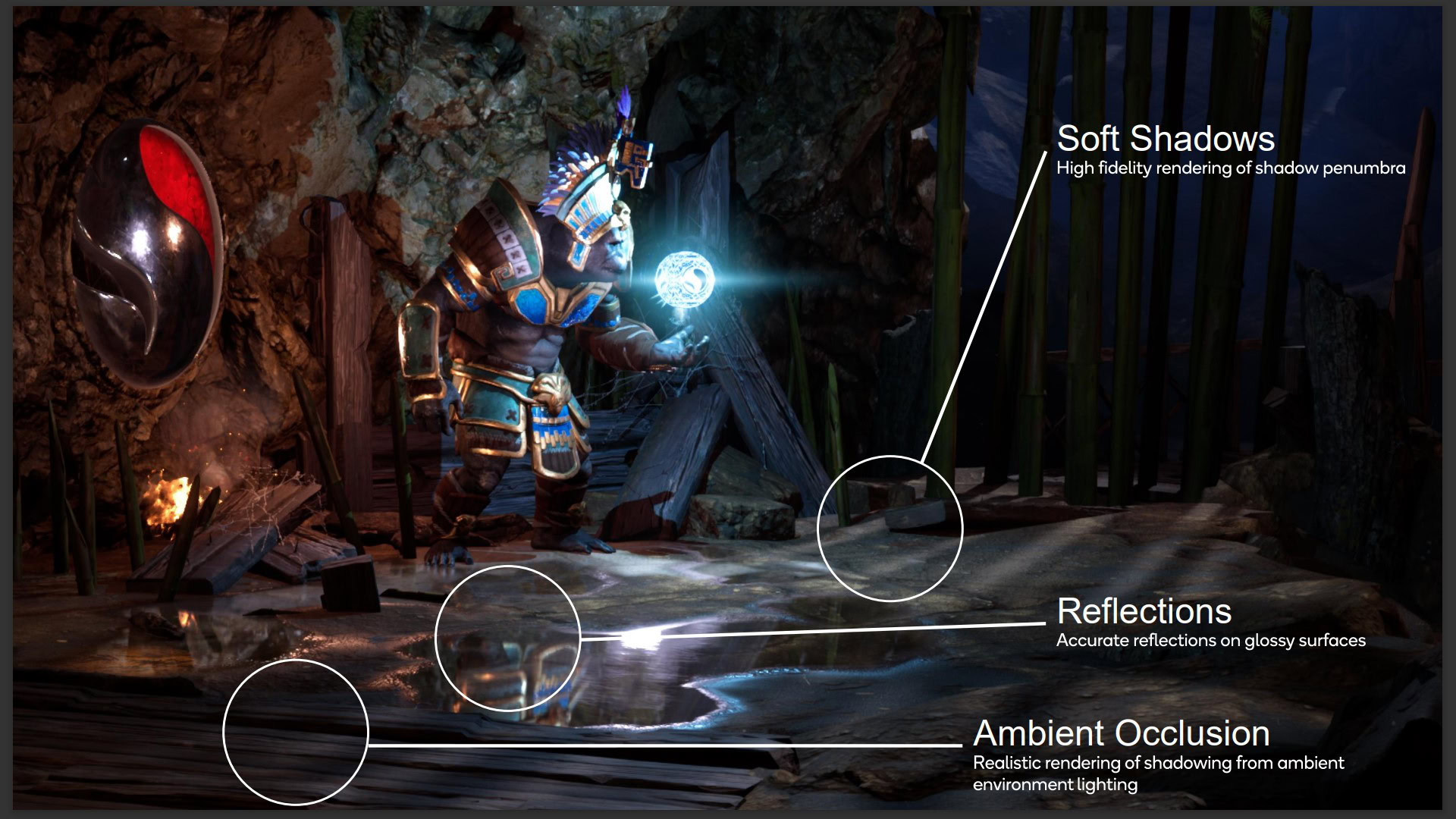
Nevertheless, the GPU now accelerates the rendering of soft shadows, reflections, ambient occlusion, and global illumination in ray tracing-capable Vulkan Android games in ways that can’t be done in software, according to Qualcomm. So games should look that bit nicer in the years to come. Speaking of, Qualcomm sees hardware-accelerated ray tracing arriving in the AAA games in the first half of 2023.
The first mobile game with ray tracing support is expected in 2023.
In addition to ray tracing support, the latest, nameless Adreno GPU (known as the Adreno 740 internally) promises 25% more performance and up to 45% power savings over the previous generation, depending on the use case. It supports the Vulkan 1.3 API, and Qualcomm has optimized its drivers to provide a further 30% performance improvement in some Vulkan-powered scenarios. Qualcomm is also the first to claim support for Unreal Engine 5’s Metahumans framework, while its Adreno Display engine boasts Adaptive HDR, HDR Vivid, HDR10+, Dolby Vision, and OLED Aging Compensation features. This all sounds like a big win for Snapdragon gamers this year.
Extra AI for imaging and more
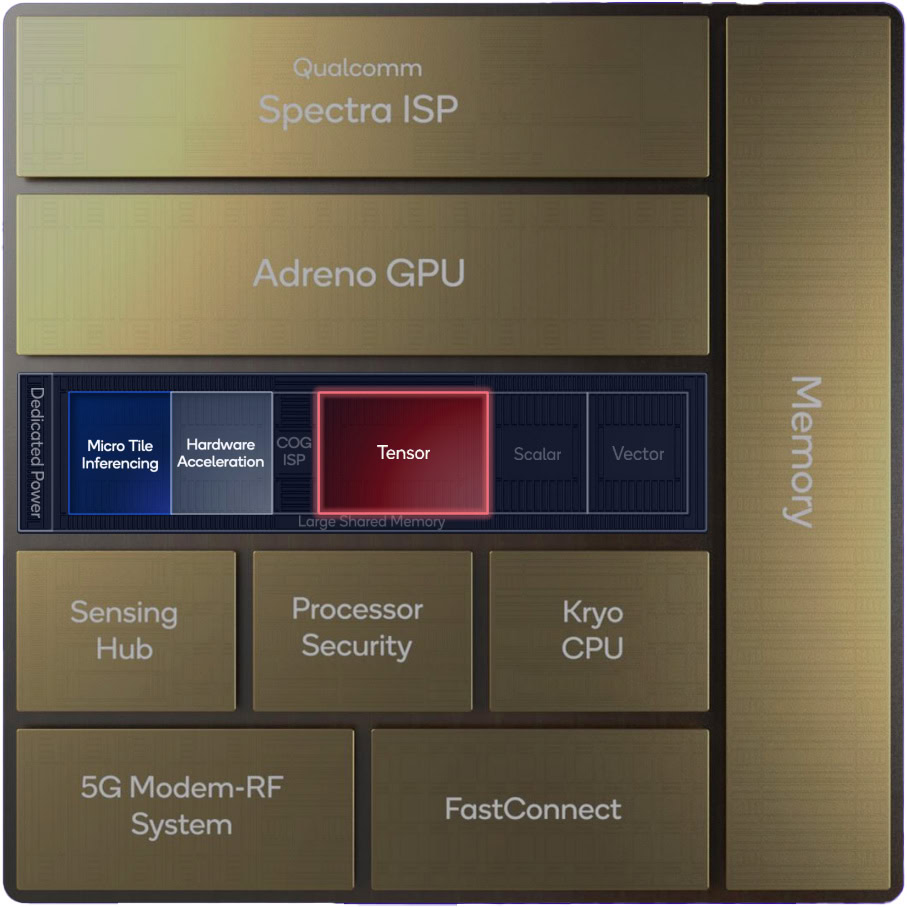
Qualcomm has been pretty hot on imaging capabilities in previous years and, although not touting huge numbers for us to ogle at this time, does have some crucial improvements here too. Before getting to the imaging smarts, let’s dive into what’s new with Qualcomm’s latest Hexagon DSP, the heart of the Snapdragon 8 Gen 2’s system-wide AI Engine.
A few seemingly small improvements add up to quite a lot. For starters, there’s now a dedicated power delivery system, meaning that the Hexagon DSP can run without having to clock other components simultaneously, such as the GPU. A unique power domain is a win for efficiency. In that vein, Qualcomm claims a 60% improvement in performance per watt over the previous generation when running certain AI models.
Qualcomm's Hexagon processor doubles its Tensor crunching capabilities and brings low-resolution INT4 ML support.
To boost performance, the Tensor accelerator inside the DSP has doubled in size for twice the performance and has new optimizations specifically for language processing. Qualcomm is also debuting what it calls micro tile inference support, essentially chopping up imaging and other problems into smaller tiles to save on memory at the expense of some result accuracy. Along those lines, the addition of INT4 also means that developers can now implement machine learning problems requiring high bandwidth at the expense of some accuracy if compressing a larger model. For example, running the Stable Diffusion AI image generator on a smartphone without an internet connection. Qualcomm is providing tools to partners to help support INT4, so it will require a retooling of existing applications to work.
The Snapdragon 8 Gen 2 Hexagon DSP offers 4.35x the performance of its predecessor, depending on the ML model (in this case, Qualcomm is comparing mobileBERT natural language processing). That sounds impressive, but the more significant change is the introduction of Hexagon Direct Link, which more closely connects its ISP to the AI Engine. The company dubs this its “Cognitive ISP.”
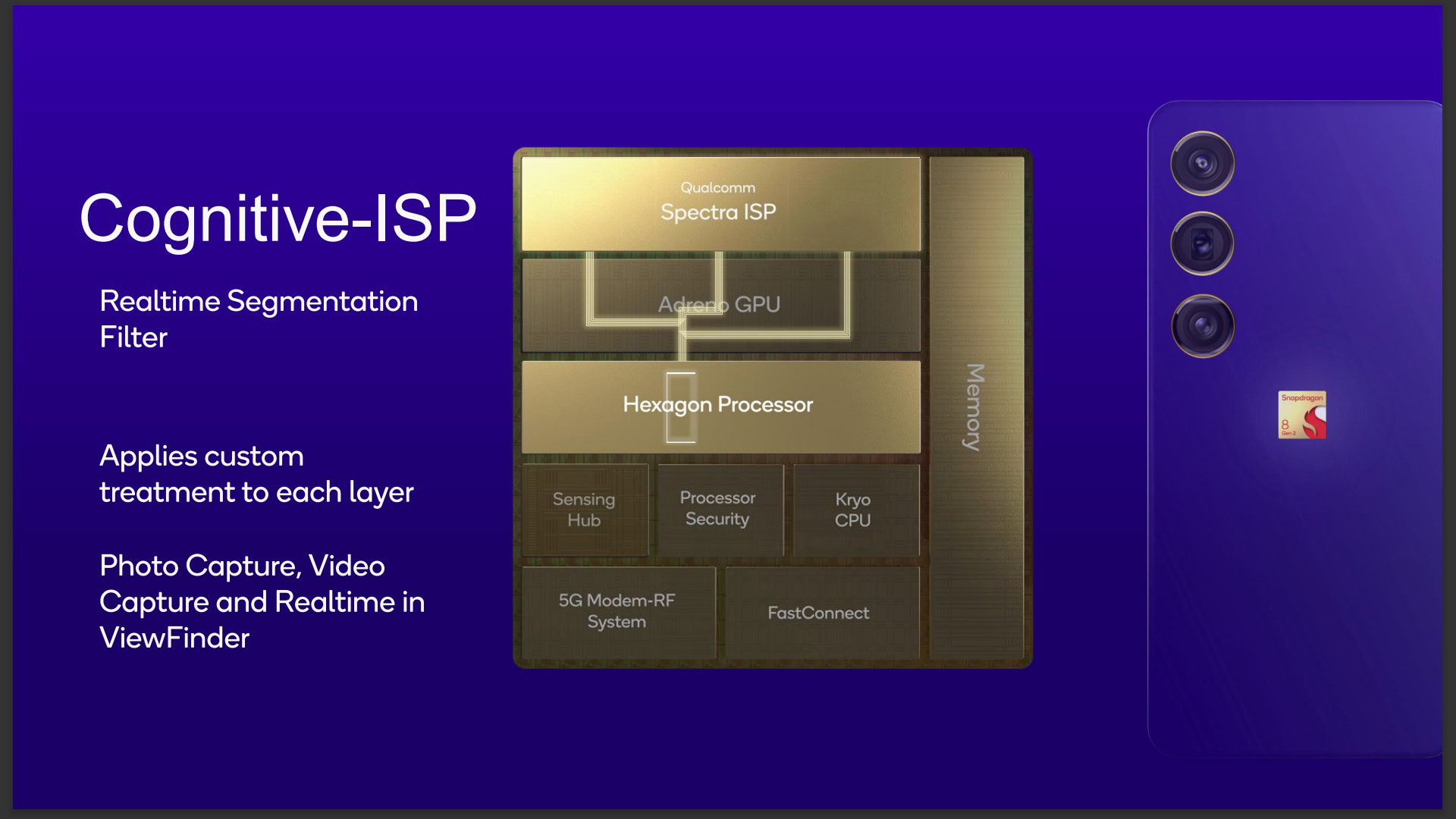
Qualcomm doubled the physical link between the image signal processor (ISP), Hexagon DSP, and Adreno GPU, driving higher bandwidth and lowering latency. This allows the Snapdragon 8 Gen 2 to run much more powerful machine-learning tasks on imaging data right off the camera sensor. RAW data, for instance, can be passed directly to the DSP/AI Engine for imaging workloads, or Qualcomm can use the link to upscale low-res gaming scenarios to assist with GPU load balancing.
Hexagon Direct Link increases bandwidth for passing imaging and other data directly to the AI Engine, bypassing sluggish DDR memory.
Qualcomm’s prime use case for Hexagon Direct Link is for image segmentation and processing. In other words, identifying key aspects of a scene, such as facial landmarks, plants, the sky, etc., to create layers in real-time and then apply custom processing to these layers before even hitting the shutter button.
If this sounds somewhat familiar, it’s because Qualcomm has been moving various machine learning-type features closer to the ISP in previous years, including face detection and segmentation for video bokeh capabilities. It certainly claimed segmentation capabilities last-gen. However, the slower link meant that imaging data was previously often pulled into main memory first, a costly and high-latency procedure that usually resulted in applying segmentation after capture. Qualcomm is reducing that bottleneck this year, making it much more feasible to run complex workloads, such as imaging problems, on its AI Engine in real-time. However, it’s up to Qualcomm’s product partners to leverage these capabilities.
More wireless connectivity options
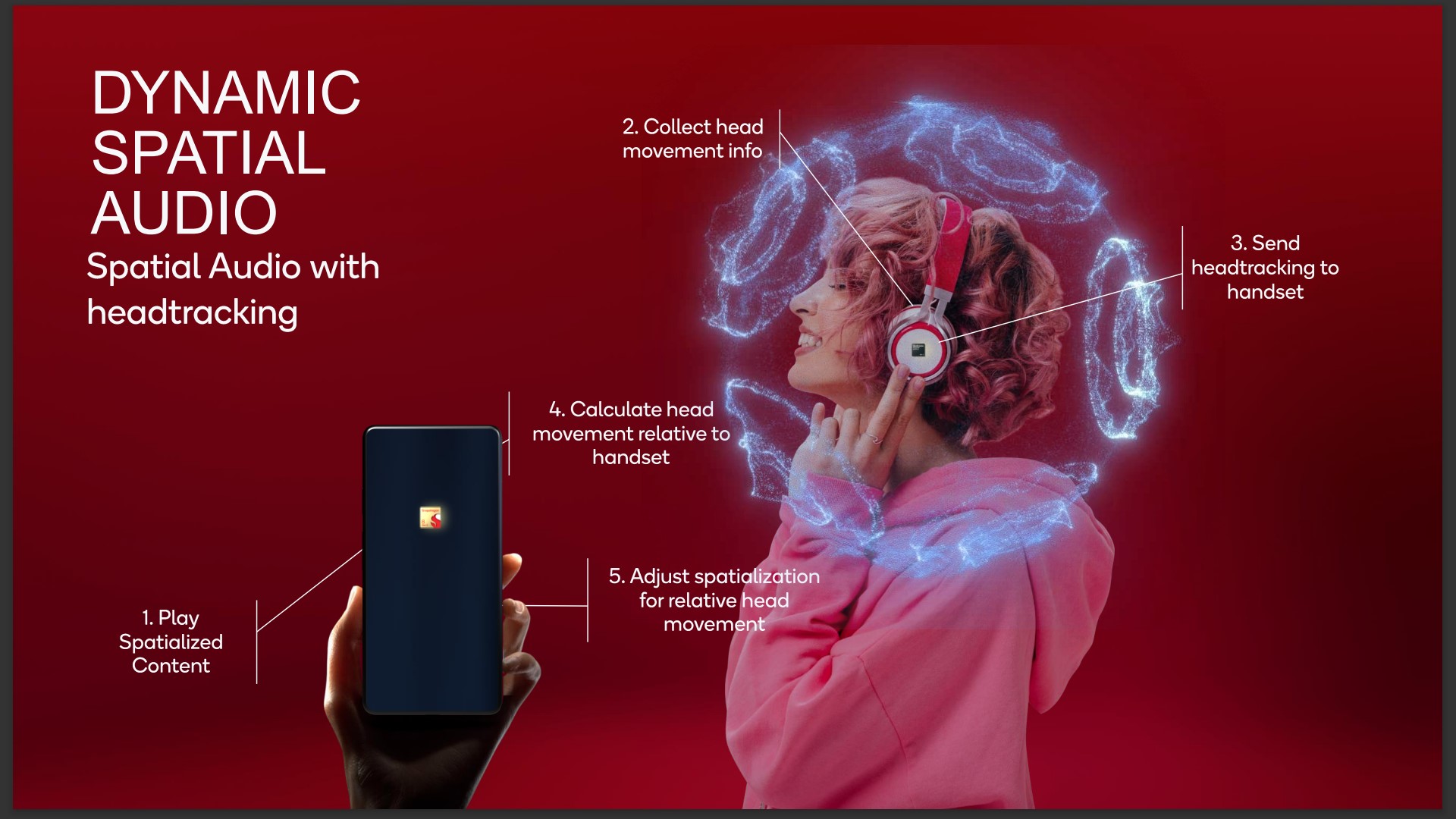
Let’s start with the more exciting, user-defining new connectivity features. The chip’s updated Snapdragon Sound audio suite now includes Dynamic Spatial Audio capabilities. By dynamic, Qualcomm means you can now move your head around within the space and hear the content move around you rather than following your head statically, thanks to dynamic head tracking on compatible headphones. This technology works with most existing multi-channel spatial audio formats and decoders, such as Dolby Atmos and Sony 360 Reality Audio.
Sticking with audio, Qualcomm’s aptX Lossless codec is now supported in both Bluetooth Classic and LE Audio use cases, combining the benefits of low energy and lossless audio playback for future products. For gamers, wireless latency can fall to just 48ms with a compatible headset — that’s 47% lower than its predecessor.
Music lovers benefit from Dynamic Spatial Audio and lossless Bluetooth streaming.
If you thought the dust had settled on 5G, think again. Qualcomm is shaking a few things up with the Snapdragon 8 Gen 2. Built with an integrated Snapdragon X70 modem, which offers speeds of 10Gbps down and 3.5Gbps up via 4x carrier aggregation, there are AI smarts onboard too.
Qualcomm claims that the modem’s AI capabilities allow it to improve the throughput and connectivity robustness of both sub-6GHz and mmWave connections, particularly at the cell edge. Perhaps more practical, though, is support for dual active 5G SIMs. So you can continue to receive messages and data on a secondary 5G SIM while taking a call on the first.
Qualcomm rounds out its latest Snapdragon Connect suite with early support for Wi-Fi 7, as well as Wi-Fi 6 and 6E. Although the spec isn’t finalized, Qualcomm is leveraging its inside track to support the standard early. The promise is up to 5.8Gbps data speeds over a 320MHz channel in the 6GHz band via High Band Simultaneous Multi-Link. This comes with a latency of just 2ms, which Qualcomm says will be invaluable in supporting cloud gaming, XR, and other latency-dependent applications. Of course, you’ll need a Wi-Fi 7 router to benefit, but those are only on sale in China at the time of writing. One to slap on the futureproof items list, then.
Other Snapdragon 8 Gen 2 features
Sifting through the launch presentations and press materials, here are a few other Snapdragon 8 Gen 2 features worth highlighting:
- This is Qualcomm’s first processor to support AV1 playback at up to 8K 60fps. All major SoCs heading to future Android phones now support AV1 decoding.
- Dual Bluetooth radios promise to double the connectivity range and speed up device pairing.
- Snapdragon 8 Gen 2 is tuned to support new image sensors, namely the 200MP Samsung ISOCELL HP3 with real-time remoasiac, and Sony’s quad digital overlap HDR video technology in the IMX800 and IMX989.
- Qualcomm hasn’t made spec changes to its ISP capabilities since the 8 Gen 1. There’s the same 200MP single-shot camera, 36MP triple camera capture, and 4K HDR simultaneous capture features as last year.
- Qualcomm has added a second AI processor to its 4th generation Sensing Hub. Combined with 50% more memory, there’s now twice the performance on offer here to leverage technologies like Qualcomm’s always-sensing camera to apply privacy screen features.